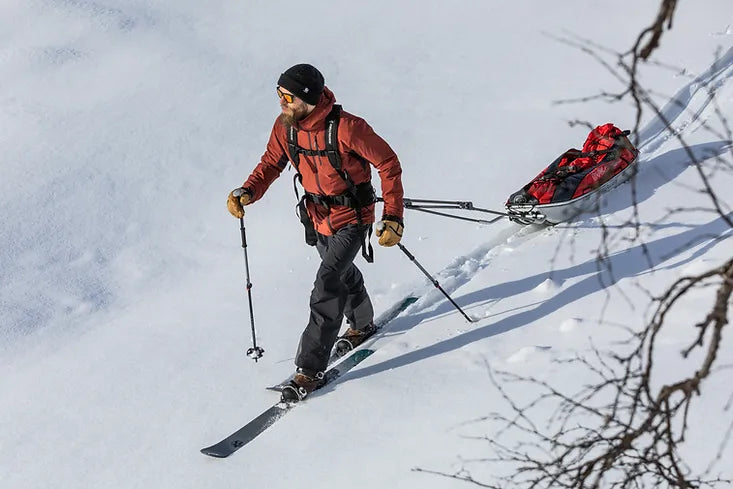Who wants to go trekking with a sled or pulk this winter? Sleds and pulks are a great way to travel with your gear over snow-covered terrain. You also don't have to be an Arctic explorer to see and feel the benefits of using them. Even weekend trips in the winter can be an appropriate time to use a sled or pulk, but the longer your trip is, the more a necessity it becomes.
Winter trekking opens a whole new dimension to wilderness explorers and backpackers alike. The same trails hiked during spring, summer and fall can appear totally new and wondrous when covered by a snowy blanket during the winter months. Before jumping in, there are a few equipment-related points to consider before hitting the wintry trails.
Firstly, you will need the proper tools to carry you across the snow. For longer outings and in varied terrain, the KAR is a top choice. Its optimal length and weight make this skishoe an agile companion, and its steel edges give you just the right amount of edge control. Furthermore, the KAR is a perfect tool for hauling a sled.

The KAR is a top choice for winter trekking.
When Should You Choose a Sled?
A sled or a large backpack is a necessity for longer winter hikes. For most treks you will need at least a tent, thick sleeping bag, insulating sleeping mat, warm clothes, food and water, fire-making supplies, navigation and emergency equipment (including a phone and extra batteries, map, and a first-aid kit), and a reliable cooking system. When choosing between a backpack and sled, one should always consider the terrain they will be traveling through. If you are planning to travel mainly through thick, dense forest, hiking with a backpack might be the easier option. However, the weight of all the necessary equipment can add up quickly. For most other terrain types and situations, a sled (also known as a sledge or pulk) will be the preferred way to travel with your gear over snow-covered terrain.
You don't have to be an Arctic explorer to benefit from using a sled either. When you are planning family outings, having a sled is handy. Traveling with kids on a sled can be a great way to get the whole family moving and enjoying the winter season. Even one-night, weekend trekking trips in the winter can be a great opportunity to use a sled. Of course, the longer your trip is, the more of a necessity it becomes.
We recommend starting your family adventures with simple, short, low-intensity trips to build stamina for both the skier and rider. As confidence grows, so can the scope of your adventures!
What to Consider When Choosing a Sled?
There are many different kinds of commercially available sleds and pulks that are suitable for winter trekking with Skinbased skis. Some crafty people even build their own! An ideal sled is one that is stable, secures the load well, and allows for quick and easy access to your items. When packing, do your best to keep the load low and distribute the weight so that the rear of the sled is slightly heavier than the front. This will help the nose of the sled to ride slightly higher, encouraging better floatation.
Choose your sledge so that it is quite a bit bigger in volume than what you plan to fill up. This will allow you to spread the weight of your trip's necessities across a greater surface area, helping to keep the sled's center of gravity low and making it more stable. Also, consider having space on your pulk for a large, unstuffed, warm jacket, foam sleeping mat, or even your entire tent. Leaving your tent unstuffed with the poles already in it can save a ton of time when moving camp everyday, especially in very cold temperatures when fingers dexterity is often compromised.
In addition, think about the length and width of your pulka, and what is most appropriate for the terrain you will be traveling though. Wider sleds are more stable and quicker to turn, but can often get caught in narrow passages between trees and are generally less efficient to pull. Longer sleds can be more unstable on uneven terrain, but track better and are more efficient on level ground.
Sleds and pulkas always rely on some form of harness and tracer (poles or cord that run between the sled and the harness) system to attach the load to the user. There are many commercially available harness and tracer systems, and some pulkas even come with their own system. While most people prefer to use a dedicated harness, some simply use the shoulder straps of their backpack. Though for both durability and comfort, a proper harness is best. Tracers come in a wide variety of styles and forms, but there are two predominant types: rigid systems made of aluminum, carbon or glass fiber poles, and non-rigid systems, consisting only of cord. Both rigid and non-rigid systems have their own pros and cons, but mainly this comes down to personal preference only gained through experience and experimentation. For starting off, either will suffice.

Trekking with a sled
As with most new hobbies, we highly recommend beginning with a few simple and easy trips before trying to tackle any bigger challenges. The ideal first trip should focus only on the experience of winter trekking, leaving other, more specific goals for the future. These simple, short, low-intensity trips will help to build both stamina and skills. As confidence grows, so can the scope of your adventures!
__________
With autumn setting in, now is the perfect time to start dreaming up and planning your winter trekking adventure. We hope this post can help get you started off on the right foot. Where do you dream of spending nights this winter?

0 kommentarer